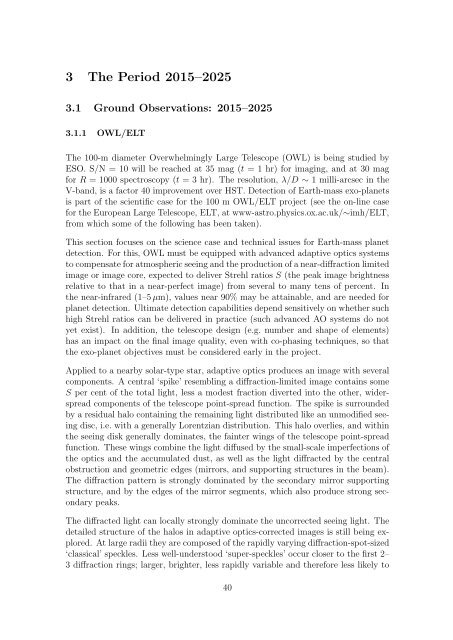Report - School of Physics
Report - School of Physics
Report - School of Physics
Create successful ePaper yourself
Turn your PDF publications into a flip-book with our unique Google optimized e-Paper software.
3 The Period 2015–2025<br />
3.1 Ground Observations: 2015–2025<br />
3.1.1 OWL/ELT<br />
The 100-m diameter Overwhelmingly Large Telescope (OWL) is being studied by<br />
ESO. S/N = 10 will be reached at 35 mag (t = 1 hr) for imaging, and at 30 mag<br />
for R = 1000 spectroscopy (t = 3 hr). The resolution, λ/D ∼ 1 milli-arcsec in the<br />
V-band, is a factor 40 improvement over HST. Detection <strong>of</strong> Earth-mass exo-planets<br />
is part <strong>of</strong> the scientific case for the 100 m OWL/ELT project (see the on-line case<br />
for the European Large Telescope, ELT, at www-astro.physics.ox.ac.uk/∼imh/ELT,<br />
from which some <strong>of</strong> the following has been taken).<br />
This section focuses on the science case and technical issues for Earth-mass planet<br />
detection. For this, OWL must be equipped with advanced adaptive optics systems<br />
to compensate for atmospheric seeing and the production <strong>of</strong> a near-diffraction limited<br />
image or image core, expected to deliver Strehl ratios S (the peak image brightness<br />
relative to that in a near-perfect image) from several to many tens <strong>of</strong> percent. In<br />
the near-infrared (1–5 µm), values near 90% may be attainable, and are needed for<br />
planet detection. Ultimate detection capabilities depend sensitively on whether such<br />
high Strehl ratios can be delivered in practice (such advanced AO systems do not<br />
yet exist). In addition, the telescope design (e.g. number and shape <strong>of</strong> elements)<br />
has an impact on the final image quality, even with co-phasing techniques, so that<br />
the exo-planet objectives must be considered early in the project.<br />
Applied to a nearby solar-type star, adaptive optics produces an image with several<br />
components. A central ‘spike’ resembling a diffraction-limited image contains some<br />
S per cent <strong>of</strong> the total light, less a modest fraction diverted into the other, widerspread<br />
components <strong>of</strong> the telescope point-spread function. The spike is surrounded<br />
by a residual halo containing the remaining light distributed like an unmodified seeing<br />
disc, i.e. with a generally Lorentzian distribution. This halo overlies, and within<br />
the seeing disk generally dominates, the fainter wings <strong>of</strong> the telescope point-spread<br />
function. These wings combine the light diffused by the small-scale imperfections <strong>of</strong><br />
the optics and the accumulated dust, as well as the light diffracted by the central<br />
obstruction and geometric edges (mirrors, and supporting structures in the beam).<br />
The diffraction pattern is strongly dominated by the secondary mirror supporting<br />
structure, and by the edges <strong>of</strong> the mirror segments, which also produce strong secondary<br />
peaks.<br />
The diffracted light can locally strongly dominate the uncorrected seeing light. The<br />
detailed structure <strong>of</strong> the halos in adaptive optics-corrected images is still being explored.<br />
At large radii they are composed <strong>of</strong> the rapidly varying diffraction-spot-sized<br />
‘classical’ speckles. Less well-understood ‘super-speckles’ occur closer to the first 2–<br />
3 diffraction rings; larger, brighter, less rapidly variable and therefore less likely to<br />
40
















